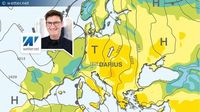As the Easter weekend approaches, Germany is experiencing an unusual weather phenomenon that has surprised meteorologists and left the public in awe. While the eastern regions bask in nearly summer-like temperatures, the western areas are shivering under gloomy skies and unseasonably cold weather. This stark contrast has been attributed to a weather front caused by the low-pressure system "Darius," which has split the country into two distinct climatic zones.
On Wednesday, April 16, and Maundy Thursday, April 17, 2025, temperatures in eastern Germany are expected to soar to a remarkable 29 degrees Celsius, surpassing the warmth of traditional holiday destinations like Lisbon and Palma. "Such values are very unusual for mid-April and resemble high summer conditions. It’s really crazy," said meteorologist Dominik Jung from wetter.net. The warm air is streaming in from Eastern Europe, creating a perfect environment for T-shirt weather, while the western regions struggle with temperatures barely reaching 10 degrees Celsius.
As the sun shines brightly in the east, the western half of Germany is dominated by thick clouds and rain. On Maundy Thursday, the temperature in the east will climb again to between 27 and 29 degrees Celsius, while the west will experience highs of only 9 to 14 degrees. This weather division is so pronounced that Berlin is currently warmer than cities like Rome, Barcelona, and even Mallorca.
On Good Friday, April 18, temperatures in the east will still reach up to 22 degrees Celsius, whereas in the west, particularly in areas like the Eifel or along the North Sea coast, temperatures will struggle to exceed 10 degrees. The day is expected to bring more clouds and some rain, especially in the eastern half of the country, but the warmth will persist in the east.
As Easter Sunday approaches, meteorologists predict that it will be the warmest and sunniest day of the holiday weekend, with temperatures potentially reaching up to 26 degrees Celsius. "Easter Sunday will be the friendliest and warmest day of the entire Easter weekend across Germany," Jung explained. With the arrival of this high-pressure system, outdoor activities will be in full swing, with parks expected to be bustling with visitors enjoying the pleasant weather.
However, the joyous weather will be short-lived. By Easter Monday, April 21, a significant weather shift is anticipated, with a drop in temperatures of up to ten degrees Celsius. As dense clouds move in from the west, rain and strong gusts are expected, particularly affecting regions like North Rhine-Westphalia, Rhineland-Palatinate, and parts of Lower Saxony. This change will bring an end to the spring-like conditions, leaving many outdoor plans in disarray.
In Lower Saxony, the weather on April 19 is expected to be initially cloudy and rainy, with temperatures reaching a maximum of 17 degrees Celsius in the Grafschaft Bentheim, 11 degrees on the islands, and between 12 to 15 degrees in the inland areas. As the weekend progresses, temperatures will rise to 21 degrees in the far east and between 13 to 19 degrees in the interior on Sunday.
On Easter Monday, the forecast indicates temperatures will range from 13 to 17 degrees on the islands and 17 to 18 degrees inland, with the eastern regions again enjoying the highest temperatures, possibly reaching 20 degrees Celsius near the Saxony-Anhalt border.
Despite the anticipated rain, the precipitation may not be enough to alleviate the dryness that has been prevalent in recent weeks, particularly in parts of Lower Saxony where there is an ongoing risk of forest fires. Meteorologist Sabine Krüger from the DWD noted, "Even if there is localized heavy rain, it will not compensate for the dryness of the past weeks." This concern highlights the ongoing challenges posed by climate change and the need for effective measures to manage water resources.
Overall, the weather over the Easter weekend is a reminder of the unpredictable nature of spring in Germany. While the eastern regions enjoy a taste of summer, the western areas must contend with the remnants of winter, creating a unique and fascinating weather scenario. As meteorologists closely monitor the situation, the public is left to navigate the challenges and joys that come with such extreme weather contrasts.
As the weather border continues to shift, it remains to be seen how long this division will last. Meteorologists are observing the developments with keen interest, noting that such a strong temperature gradient over short distances is rare and could have implications for the upcoming weeks. With the potential for further weather anomalies, it’s clear that Germany is experiencing an extraordinary meteorological spectacle that will be remembered long after the Easter holiday.







